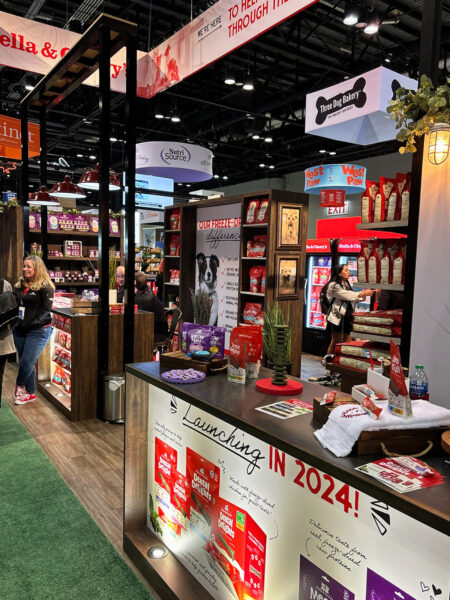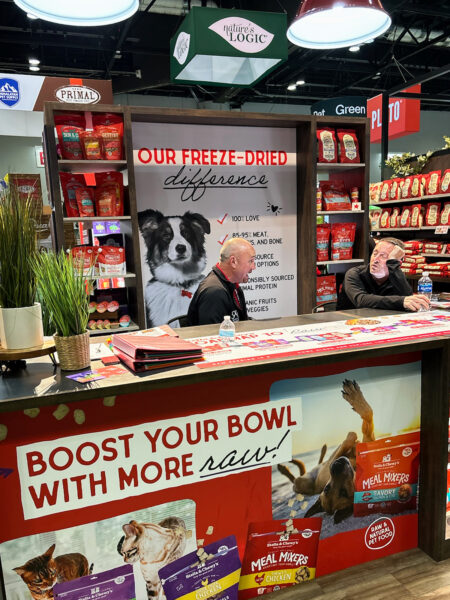News
What I learned between Global Pet Expo and VMX.
Dr. Blair McConnel’s Pet Care Insights From 2 Major Veterinary Conferences
In just over a year, I attended two pet conferences at the same location: the Orange County Convention Center in Orlando. Frankly, I was astonished at how different my experiences were.
In January of 2023, I attended VMX, an annual gathering of the North American veterinary community. I’ve attended this show many times and, as always, the convention floor was comfortably crowded. The veterinarian attendees make this a loud, buzzy affair: visiting booths, attending continuing education seminars, and catching up with old colleagues and industry news.
Last month, I attended the Global Pet Expo in the same space, but the mood was noticeably different. That’s partly due to the nature of this show: an invite-only retail-focused event limited to independent retailers, distributors, mass-market buyers and other qualified professionals. While there were more booths, the Global Pet Expo had fewer attendees and felt less splashy. Most events happened on the convention floor versus how VMX panels and parties spill out to surrounding hotels.



The Global Pet Expo revealed three trends in particular:
1. Pet retail is growing saturated.
2. Raw/novel protein pet food is struggling for footing.
3. Pet food messaging is continuing to evolve and converge.
First, the differences in crowd size between the two shows spoke to the changing nature of retail. Expo veterans I spoke with estimated that attendance was down anywhere from 25%-40%. The explosion of digital brands and purchasing options may have kept away owners of brick-and-mortar pet specialty stores; all the new product options may just be too much. After all, those retailers can only stock so many SKUs compared with digital’s essentially limitless long tail. If these store owners feel their product sort works, they might not feel a need for new options.
Nevertheless, big companies continue to introduce line extensions and new products. Purina alone debuted more than 10 at the show.
Next, while the idea of raw pet food would seemingly appeal to millennial pet parents, product adoption simply hasn’t happened at scale. Worse, the inflating cost of everything from rent to groceries may also have a belt-tightening impact on this younger market’s spending. One company noted that super-premium and raw food was 30% of the regional store market a couple years ago but it’s since dropped to 15%.
The journey to bring raw food for pets to market is oddly similar to selling plant-based meat. In the late 2010s, a wave of products launched with a goal of converting meat eaters to at least flexitarian behavior. While consumers were keen to try them, repeat purchase faltered. Given a higher price point without compelling nutritional claims, plant-based meat growth stalled. That is exactly where the raw food/novel protein pet food market finds itself today.
Finally, these declining market trends have encouraged product convergence. Raw food companies now offer kibble products while predominantly kibble companies, such as Fromm, are launching “gently cooked” products.
Such convergence examples abound. Greenies, long known for its pill pockets and dental chews, displayed its move into pet kibble while pet food titan Purina launched dental and teething chews. Even Stella & Chewy’s, long a raw pet food stalwart, showcased its move into dental chews.
As the offerings converge, their sales messages evolve, primarily from highlighting unique products to unique processes. Open Farm emphasized products sourced from farms with specific animal welfare practices or the ability to track the foods’ journey from farm to bag. Stella & Chewy’s emphasized its freeze-dried production. Still, with so many similar products, many companies still emphasize product attributes instead of outcomes to try to drive differentiation. Greenies was one notable departure from this trend, emphasizing its products’ impact on six biological systems.
Much like a litter of Labrador puppies, the pet care world simply doesn’t sit still for very long. Being out among the veterinarians and retailers driving those changes and trends makes all the difference in how we maintain the advantage of ongoing insight for our pet care clients.
About the Author
Blair McConnel brings extensive experience to the Bader Rutter Pet Care Practice. She is a veterinarian who worked in the industry for 10 years and led Zoetis’ marketing team. She has led several startups, including two businesses that provided people management and business consulting services to veterinarians. Her passion is growing businesses, and her belief is that good strategy is the foundation to growth.

